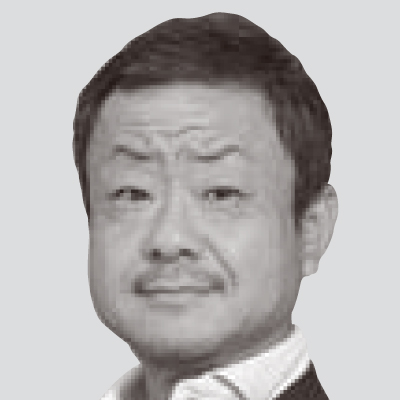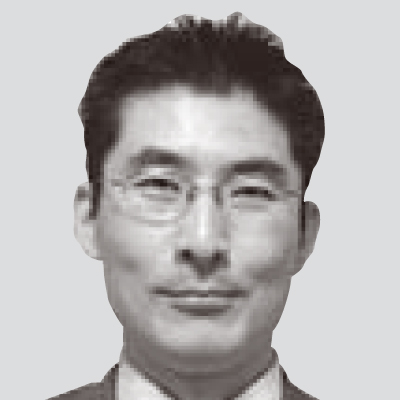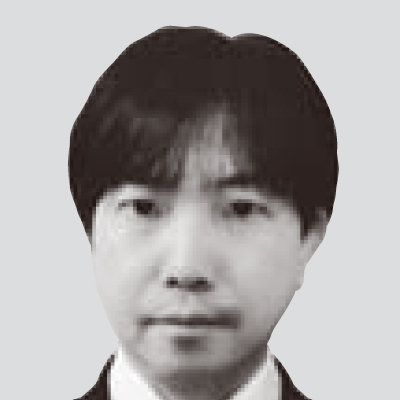Smart Life Businesses for Better Urban QoL
What Hitachi means by a “Smart Life Business” is the utilization of new digital technologies such as the IoT and AI to provide consumers with services that help improve QoL. The intention is to draw on product technologies and contacts with consumers acquired through BtoC businesses, primarily home appliances, to realize Hitachi’s idea of a “Smart Life” in various areas of people’s lives.

Smart Life Business Division, Smart Life & Ecofriendly Systems Division, Hitachi, Ltd. Current work and research: Planning, development, and promotion of Smart Life Business.

Business Platform Department, Smart Life Business Division, Smart Life & Ecofriendly Systems Division, Hitachi, Ltd. Current work and research: Planning and development of Smart Life Business and construction of solution platforms.

IoT Products Planning Department, Products Strategy Planning Division, Home & Eco Appliances Group, Hitachi Appliances, Inc. Current work and research: Planning and development of connected home appliances and promotion of service businesses.

Business Development Department, Smart Life Business Division, Smart Life & Ecofriendly Systems Division, Hitachi, Ltd. Current work and research: Planning, development, and promotion of Smart Life Business.

Business Development Department, Smart Life Business Division, Smart Life & Ecofriendly Systems Division, Hitachi, Ltd. Current work and research: Planning, development, and promotion of Smart Life Business.
Back in the 1960s, a time when Japan was enjoying rapid economic growth, people built up relationships of mutual assistance in many different areas of their lives through their local communities. Examples include neighborhood associations holding festivals or the elderly playing with children, and it could be described as a way of life that fostered local activities and people helping one another by drawing on the close relationships between residents.
Hitachi launched a steady stream of home appliances during this time. The approach to product development adopted by Japanese home appliances manufacturers back then, Hitachi among them, was to focus on functionality as a way to improve their products and thereby reduce the burden of housework. The percentage of households with home appliances such as washing machines is now above about 90%*1, and these appliances are helping achieve comfort and convenience by reducing the burden of housework in many homes.
Meanwhile, the shape of Japanese families has changed considerably over that half-century in terms both of the types of household and their demographics. Average life spans for Japanese people exceed 80 years for both men and women, and Japan is approaching a time when it is no longer unusual for people to live beyond 100 years. It is predicted that one-third of the population will be elderly (65 or older) in 2025. People in this age group can find it physically difficult to go out to the shops, with incidents of injury or accident in their daily life also becoming more common.
Meanwhile, the proportion of households in which both partners are working has reached 60%*2, meaning that it is now commonplace for nobody to be at home during the day. A survey by Hitachi has found that, for partners who both work, being kept busy by work and childcare, and not having a chance to relax even at home, is a cause of dissatisfaction in their lives.
In response, Hitachi set out to identify the specific needs that people have in different areas of their lives, covering different generations and different types of household (see Figure 1). This article describes the Smart Life that Hitachi is seeking to create, as exemplified by services currently under consideration that are intended to meet these needs.
Figure 1—Needs of Different Household Types and Age Groups in the Era of 100-year Lifetimes Whereas households in which both partners are working or those at an age where they are caring for children are seeking to make good use of time, the needs of the elderly relate to health and making their lives easier.
Whereas households in which both partners are working or those at an age where they are caring for children are seeking to make good use of time, the needs of the elderly relate to health and making their lives easier.
To create a Smart Life, it is crucial to get close to consumers and understand the difficulties that arise in different areas of their lives. Time is precious for people who are caring for children or living in households where both partners work. This means that time spent on laundry, including getting it dry, folded, and put away, has the potential to get in the way of their spending time with their children or communicating with the rest of the family. This section considers the frustrations associated with doing the laundry and describes how Hitachi has focused on this area of people’s lives (getting clothes clean).
Hitachi launched its first electric washing machine more than half a century ago in 1952. Prior to that, people had to endure cold water and wash their clothes by hand, something that was not only awkward and time-consuming but was also hard work. The arrival of the washing machine, however, reduced the effort required and shortened the time taken by hand washing, freeing people up to spend more time with their families, including looking after children. The models currently sold in Japan have advanced since then and now come with a Wind Iron function that smooths out the wrinkles in clothes during drying to make ironing faster and easier.
Meanwhile, the environment in which we live has been changing, and consumers are frustrated at times when high levels of pollen or fine particulate matter (PM2.5) mean that clothes cannot be hung outside to dry. There is also demand from consumers for services that free up time by coming to the home to clean and tidy while the residents are out at work or doing shopping or leisure activities, or for dedicated clothes drying services that are only called on when people do not want to hang their washing outside, such as when the weather is bad or during the pollen season. As lifestyles become more diverse, Hitachi expects that consumer needs will increasingly be for “flexible access to laundry services,” evolving in the direction of new services that allow laundry to be done anywhere and without being constrained by time considerations.
The approach to product development adopted by many home appliances manufacturers in the past has been to focus on functionality, incorporating additional features in the hope of satisfying the diverse needs of users. In Hitachi’s case, this involved equipping its washing machines with such sensors as thermistors, vibration sensors, and electric conductor sensors. These made it easier to get clothes clean by setting the optimal washing time and making adjustments to the amounts of detergent and water.
As lifestyles become more diverse, however, and different households adopt different ways of living, it is getting to the stage when it is no longer possible to address the frustrations experienced by consumers simply by adding more functions. For example, by using the Internet of Things (IoT) for the predictive detection of problems and conducting appropriate maintenance before the washing machine develops a fault, it is possible to provide new value in the form of avoiding the inconvenience of not being able to do the laundry at home while the machine is being repaired.
Moreover, households where nobody is at home during the day (people living alone or with both partners working) will find it convenient to be able to control their washing machine while they are out, such as during working hours. This requires that home appliances be “connected” so that they can be operated from a portable device via a link to a network.
Given the ability to modify or extend functions by downloading an application from the network, it becomes easy to provide operation from a smartphone or other device that people already have. Likewise, if function updating is available, new generations of washing machine can be made available that suit different consumer lifestyles. The use of Hitachi’s latest digital technology is expanding the possibilities for washing machines used in the home.
This section describes the Smart Life Business that Hitachi is seeking to establish and that targets three areas of people’s lives: keeping clothes clean, keeping food fresh, and cooking. The future connection of home appliances to the IoT will lead to a shift away from pursuing functional enhancements to standalone products and toward using services to overcome the frustrations people experience in different areas of their lives.
Housework is a concern for more than a few households in which both partners work, not least being the effort involved in having to do cleaning and laundry at night after coming home from work, and that the resulting noise also risks disturbing the neighbors. In the case of people who suffer from allergies and want to avoid hanging out the washing outside during the pollen season, they find that this creates a new problem due to the smell when clothes are dried inside.
In answer to such complaints, the number of laundromats has risen in recent years. Many of the users of these laundromats are said to be people who want to be able to do the laundry whenever they want or want to dry their clothes in a dryer. This is further evidence of increasing lifestyle diversity and flexibility in access to laundry services. Depending on what best suits them at the time, people can either do their laundry at home or at a laundromat.
With the emergence of smarter ways of keeping clothes clean, it becomes possible to offer smart services not available in the past. One example might be the use of digital technology to enable the washing machine to determine when particular clothes (which the user has picked out beforehand via an application) need to be replaced based on the number of times they have been laundered, and then have the replacements home-delivered. If such a service were available, favorite clothes that people previously took such care over could instead be worn without having to worry about damaging them or getting them dirty.
It is common for people to stop off at the supermarket on the way home from work to get what they need for dinner. Unfortunately, it also happens that people buy things they do not need or fail to buy the things they do because they cannot remember what they already have in the refrigerator. Or it may be that they are late coming home from work for a number of days in a row and so are unable to find time to do the shopping at all.
A response to problems like these is to use cameras or other sensors in a refrigerator as a means for checking its contents remotely via a smartphone. Similarly, recording the use-by or best-before dates of foods and warning when these are due to expire could help reduce waste. A service for automatically ordering daily essentials when there are none left in the refrigerator should help reduce the burden that shopping places on the elderly, for example. Rather than the refrigerator merely being somewhere to keep food chilled, the availability of these services would provide new value such as replenishing food as needed and encouraging people to consume it while still fresh.
In contrast to the simple ways of using a microwave oven to prepare different sorts of meals that have become available in recent times, cooking meals the conventional way takes time and effort, such as referring to cookbooks or going to cooking school.
A variety of different voice-controlled assistant devices have also appeared on the market. If one of these is asked about how to prepare a particular meal, it will use the network to recommend a range of recipes. Once a preferred recipe is chosen, an increasing number of services are available for having the necessary ingredients delivered, and this also reduces the amount of effort involved.
As a first step in that direction, an induction hob that went on sale in February 2018 comes with a dedicated smartphone application that makes it easy to search through its repertoire of 300 recipes and send the settings for the chosen meal to the hob. This should help prevent people from misreading recipes or getting the settings wrong, encouraging them to try cooking for themselves even if unfamiliar with complicated meal preparations or how to use the kitchen facilities.
Hitachi is engaging in collaborative creation with Sanyo Homes Corporation, which operates a home appliance and housing business, to undertake a proof-of-concept (PoC) study for a service to support indoor mobility by the elderly at that company’s rehabilitation facilities.
The project collects data on elderly people walking with the assistance of one of Sanyo Homes Corporation’s indoor mobility assistance robots, using Hitachi’s IoT technology and image analysis system to analyze their patterns of movement. The aim is to develop a service that can help maintain and improve the health of the elderly by using the information obtained to provide feedback to users (see Figure 2).
It is hoped, for example, that it will be possible to offer people a fulfilling life in their old age by providing appropriate support to maintain and improve their health even when physical deterioration is already evident, such as giving them the opportunity to do the things they want to do rather than being stuck at home.
Figure 2—Use of Walking Data to Provide Lifestyle Support to Elderly Data is collected on walking using an indoor mobility assistance robot by elderly people for whom physical deterioration is a concern. Hitachi image processing technology is used to analyze patterns of walking activity, and this helps with things like ensuring that they can walk safely and the provision of appropriate assistance services.
Data is collected on walking using an indoor mobility assistance robot by elderly people for whom physical deterioration is a concern. Hitachi image processing technology is used to analyze patterns of walking activity, and this helps with things like ensuring that they can walk safely and the provision of appropriate assistance services.
Figure 3—“360° Happiness” Logo of Hitachi’s Smart Life & Ecofriendly Systems Division The message expressed by the logo is one of supplying products, practices, and services that will bring about a happy future by taking on all the different areas of life in their entirety with consideration for diversity in types of household and community circumstances, and for people at every stage of life in this era of 100-year lifetimes.
The message expressed by the logo is one of supplying products, practices, and services that will bring about a happy future by taking on all the different areas of life in their entirety with consideration for diversity in types of household and community circumstances, and for people at every stage of life in this era of 100-year lifetimes.
Hitachi’s Smart Life & Ecofriendly Systems Division has adopted “360° Happiness” as its logo for improving the quality of life (QoL) of people of different ages and with different ways of life (see Figure 3).
“360° Happiness” embodies Hitachi’s idea of taking on, in their entirety, not just the home but all the different areas of life that span home and community, thereby improving QoL by providing happiness and delight, reassurance and an emotional response to individuals of all different ages and lifestyles through the supply of services and platforms as well as products.
Rather than being held to the fixed ideas of the past, what will be important in the future will be to always adopt a consumer perspective when coming up with solutions. If it proves helpful for creating a Smart Life, this will likely include cases in which strong partnerships are formed with companies that in the past were competitors in the home appliances market. As a way to differentiate services by utilizing resources such as technology or other know-how that it lacks, Hitachi will also consider engaging in collaborative creation with companies that it has not dealt with in the past, such as those from other industries, venture businesses, and overseas companies.
Through the supply of home appliances, Hitachi has focused to date on providing convenience and comfort in the home. However, as evident by the idea of “flexible access to laundry services” whereby clothes can be washed wherever and whenever, the intended scope of this business extends beyond the home and out into the community. In the case of getting clothes washed outside the home, this includes the use of laundry services as well as doing the laundry in a laundromat washing machine (see Figure 4).
In order to provide consumers with what they are asking for, as well as using the latest digital technologies such as the IoT to make enhancements to products, it becomes important also to develop services for problems that products cannot resolve. Hitachi sees the scope of its business as covering all aspects of both products and services, both inside and outside the home, and will continue striving to develop solutions that bring innovation to people’s lives based on a consumer-centric approach.
Figure 4—Scope of Smart Life Business The Smart Life Business meets needs that arise in a variety of different areas of life, with a broad scope that extends from the home out into the community and encompasses services as well as products.
The Smart Life Business meets needs that arise in a variety of different areas of life, with a broad scope that extends from the home out into the community and encompasses services as well as products.
The activities described in this article are only some examples of what Hitachi is doing to bring about a Smart Life. Hitachi is also working on PoC studies into certain solutions.
The product technologies and contacts with consumers acquired through its business-to-consumer (BtoC) operations that deal primarily with home appliances are assets when developing new businesses, and Hitachi believes that it can resolve problems more quickly and create new value by putting know-how to work on its Lumada IoT platform.
Rather than simply supplying goods, designing ways of living from a consumer perspective can highlight new areas of life and bring happiness to all. This is the objective of the Smart Life Business Hitachi is creating for the era of 100-year lifetimes.